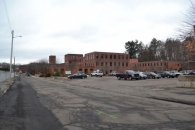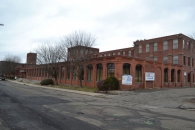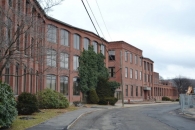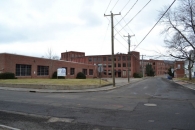Mill Record Torrington
RETURN TO ‘FIND MILLS’Disclaimer: Content for these properties was compiled in 2014-2017 from a variety of sources and is subject to change. Updates are occasionally made under Property Information, however the Connecticut Trust for Historic Preservation (dba Preservation Connecticut) makes no representation or warranty that the information is complete or up-to-date.
- Complex Name (Common)
- Torrington Co., Excelsior Needle Co. Division Plant - Excelsior Needle Co.
- Complex Name (Historic)
-
- Torrington Co., Excelsior Needle Co. Division Plant - Excelsior Needle Co.
- Address or Location
- 59 Field Street, Torrington
- County
- Litchfield
- Historic Designation
- Associated Mill Community
- n/a
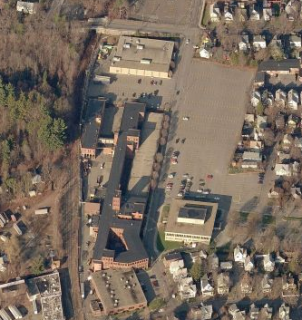 What can you do at this mill?
What can you do at this mill?
- Historic Information
Companies Associated w/Complex
- Excelsior Needle Co. 1890-1898
- The Torrington Co., Excelsior Needle Co. Division 1898-1917
- The Torrington Co., Excelsior Plant 1917-1980
Use (Historic)
Largest Documented Workforce
1,001 to 1,500 (1945)
Historic Narrative
The earliest sections of the sprawling industrial plant lining the west side of Field Street were built for the Excelsior Needle Company in 1890. The Excelsior Needle Company was established in 1866 by five of Torrington’s most prominent figures, Achille F. Midgeon, Elisha Turner, Charles Alvord, James Wooding, and George M. Isbell. Their firm initially produced sewing machine needles in a small frame building in the Daytonville section of Torrington, yet quickly outgrew these accommodations after the company’s master mechanic, William H. Dayton, dramatically improved the Hopson and Brooks Company swaging machines (cold forging) that Excelsior Needle initially used in their manufacturing processes. Dayton’s improvements allowed the firm to dramatically expand production and in 1869 this necessitated the construction of a new plant on Church Street along the railroad. The Excelsior Needle Company moved into its new plant in 1871 after having increased its capital stock from $2,000 to $25,000. Once in full operation, the new factory was capable of producing upwards of four or five million needles per year, these purchased by every sewing machine company that did not manufacture needles in house. This success continued through the 1880s and 1890s, during which time the firm acquired a number of competing plants throughout the United States. In 1890, the need for even larger manufacturing quarters required the company to relocate again, this time to Field Street, where they erected a massive red brick plant with some 400’ of frontage and various wings and secondary buildings identified at the time to be large enough to house fair sized factories in their own right. In 1896, the Torrington Register noted that, 'The plant is looked upon as a model of mill architecture. It is modern planned throughout and while pleasing in its lines it is of most substantial character. The structural formation is such that evenly excellent light is afforded in all of its different rooms… It is the most advanced of needle-making plants; it is complete in itself, every part of the work is done on the premises and the raw material received as wire, leaves the establishment in the manufactured article, ready for the consumer or user.' By the late 1890s, the Excelsior Needle Company was producing a diverse array of sewing machine needles, knitting machine needles, and hook needles, as well as spokes and nipples for bicycle wheels. The Torrington plant employed between 650 and 700 workers, a number which increased to over 1,000 as the company expanded over the course of the following decades. In 1898, the Excelsior Needle Company was absorbed into the newly established Torrington Company of Maine, a holding company organized by executives associated with Kidder, Peabody and Company of Boston, Massachusetts, Excelsior’s majority stockholder. Despite the acquisition, the Excelsior Needle Company retained its corporate existence and continued to be operated by local managers. The same was the case after the formation of the Torrington Company of Connecticut in 1917, which maintained the factory as the Excelsior Plant. Excelsior continually expanded its Field Street factory through the 1920s, with final additions coming to the north and south ends of the complex in ca. 1940 and 1964, respectively. The Torrington Company maintained the Excelsior Plant until 1980, whereupon it was sold to Groz-Beckert, a German manufacturer of industrial needles, which subsequently closed its doors and laid off the 350 workers employed at the time.
- Architectural Information
Number of Existing Buildings
Six (6) primary blocks.
Dates of Construction
1890, ca. 1900, 1905, ca. 1910, ca. 1920, ca. 1940, 1964.
Architect
n/a
Builder
n/a
Building Type
Architectural Description
The former Excelsior Needle Company plant is comprised of an adjoining complex of six primary buildings located on the west side of Field Street south of Forest Street and north of Pearl Street. The original portion of the factory was erected in 1890 and consists of a J-shaped, three-story red brick complex with three one- and two-story ells on its west (rear) elevation. The main manufacturing block originally measured roughly 400’ x 36’ and is oriented parallel to Field Street. A three-story, 96’ x 36’ manufacturing ell; one-story, 42’ x 32’ office block; and five-story, 32’ x 20’ stair tower and office block extended east from the main block towards the street line. These blocks are characterized by their brick pier construction, segmental-arched window openings with stone sills, corbelled brick cornice, and low-pitch gabled or flat roofs. The factory is dominated by its five-story stair tower, the brick piers on the four sides of which terminate in brick capitals framing round-arched windows. The Excelsior Needle Company factory was significantly enlarged in phases during the late-19th and early-20th centuries. The main block was increased to an overall length of 570’ by 1924, with a further 142’ x 64’ red brick block added to its northern end ca. 1940. A C-shaped, three-story wing was added to the southern end of the plant between ca. 1905 and ca. 1910, with various secondary blocks constructed on the west side of the complex during the same period. The pre-1924 additions generally match the details of the original factory, while the ca, 1940 block has stepped brick piers with concrete caps and stone sills and lintels. A one-story red brick manufacturing building was added in phases to the north side of the plant between ca. 1900 and ca. 1910. Flanking Field Street, this has an ashlar stone foundation and window sills, and is notable for its corbelled piers and denticulated cornice. The final primary buildings associated with the factory were erected ca. 1940 and in 1964. The first is a two-story structure built northwest of the main block and connected to the main plant by a second-floor catwalk. Used as a manufacturing building, it measures roughly 225’ x 50’ and is of similar design to the other ca. 1940 block. The second building is one-story red brick building measuring 176’ x 138’ overall. It has large steel frame windows and a flat roof.
Exterior Material(s)
Structural System(s)
Roof Form
Roof Material
Power Source
Condition
Good
Condition Notes
The complex is in generally good condition, although, most of the original fenestration has been replaced with modern units of unsympathetic character.
- Property Information
-
Specific Location
One 14.21 acre parcel on the west side of Field Street between Forest Street to the north and Pearl Street to the south.
Adjacent To
Exterior Visible from Public Road?
Yes
Parcel ID / Assessor Record Link
- 118/003/001 / Link →
Acreage
14.21
Use (Present)
- Sources
-
Form Completed By
Lucas A. Karmazinas
Date
12/22/2014
Bibliography
- List of Connecticut Manufacturers, 1922, 1924, 1930, 1932.
- Directory of Connecticut State Manufacturers, 1936, 1939.
- Atlas of Litchfield County, F.W. Beers & Co., 1874.
- Industrial Directory of Connecticut, 1947.
- Register of War Production Facilities in Connecticut, 1951.
- Sanborn Map Company, 1884, 1891, 1901, 1909, 1915, 1924, 1931, 1949.
- Aerial Survey of Connecticut, 1934, 1965.
- The Hartford Courant, 1898, 1942, 1980.
- The History of Waterbury and the Naugatuck Valley, 1918.
- Torrington Register Souvenir Edition, 1897.
- Representative View(s)Click on image to view full file

